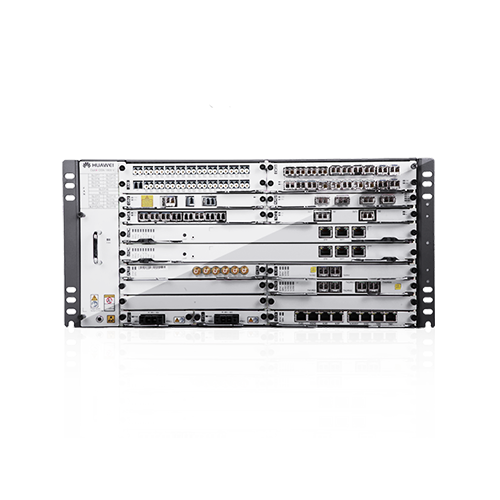
Accueil » Huawei » Huawei Optix OSN » Huawei Optix OSN 1800
The Huawei OptiX OSN 1800 is a compact, high-performance optical transmission platform designed for metropolitan and access networks. Engineered to meet the growing demands for bandwidth, flexibility, and scalability, the OSN 1800 supports a wide range of services including SDH, Ethernet, and OTN, enabling seamless transport across converged networks.
Ideal for scenarios such as enterprise access, mobile backhaul, and broadband aggregation, the OSN 1800 combines advanced transmission capabilities with a modular design, ensuring easy deployment and future-proof expansion. Its integrated architecture supports both packet and optical technologies, making it a versatile solution for carriers looking to modernize their network infrastructure while optimising space and energy consumption.
All-in-One Transport Platform
Supports SDH, Ethernet, and OTN services in a single platform, enabling efficient service convergence and simplified network management.
Compact and Modular Design
Space-saving architecture ideal for edge and access scenarios, with modular components for flexible deployment and easy maintenance.
High Bandwidth Capacity
Supports up to 40G/100G per wavelength and scalable DWDM/OTN transport, meeting increasing data demand in metro and access networks.
Flexible Networking Options
Supports point-to-point, ring, and mesh topologies, allowing operators to design cost-effective and resilient network infrastructures.
Efficient Packet Transport
Includes MPLS-TP and Carrier Ethernet features for enhanced packet-based transport, optimizing performance for data services.
Low Power Consumption
Designed for energy efficiency, making it suitable for installations where power and cooling are limited.
Advanced Management Tools
Integrates with Huawei’s U2000 and NCE management systems for unified management, fault monitoring, and service provisioning.
Carrier-Grade Reliability
Supports protection mechanisms such as MSP, SNCP, and ODUk SNC for high availability and service continuity.
Rich Service Access
Interfaces include GE, 10GE, STM-1/4/16, and OTU, enabling broad compatibility with legacy and next-gen network equipment.
Future-Proof Scalability
Ready for network evolution with support for software-defined networking (SDN) and integration into next-gen transport architectures.
OSN 1800 I: 44 x 442 x 220 mm, 3 service slots (DC) / 1 (AC)
OSN 1800 II: 88 x 442 x 220 mm, 7 service slots (DC) / 5 (AC)
OSN 1800 I Enhanced: 44 x 442 x 220 mm, 3 service slots (DC) / 1 (AC)
OSN 1800 II Enhanced: 88 x 442 x 220 mm, 7 service slots (DC) / 5 (AC)
OSN 1800 V: 221 x 442 x 224 mm, 14 service slots (DC) / 12 (AC)
Input Voltage: AC 100–240 V / DC –48 V or –60 V
Typical Power Consumption: OSN 1800 I – ~100 W, OSN 1800 II – ~200 W, OSN 1800 V – ~1000 W
Supported Services: PDH (E1, E3, T3), SDH (STM-1/4/16), Ethernet (FE, GE, 10GE, 100GE), OTN (OTU1, OTU2, OTU4, OTUC2), CPRI, OBSAI, SAN, FC, Video
Client Interfaces: SFP, XFP, SFP+, QSFP+, QSFP28, CFP, CFP2
Fiber Types: SMF (ITU-T G.652), DSF (ITU-T G.653), MMF (ITU-T G.651)
OSN 1800 I/II: OTN – 200G ODUk, Packet – 160G @ 128B, SDH – 50G (high-order), 20G (low-order)
OSN 1800 V: OTN – 700G ODUk, Packet – 700G, SDH – 280G (high-order), 40G (low-order)
Wavelength Types: CWDM – 8 wavelengths (1471–1611 nm), DWDM – up to 80 wavelengths (1529.16–1560.61 nm)
Maximum Rate per Wavelength: 100 Gbit/s (OTU4)
OTN: Line-side 1+1 protection, optical 1+1 protection, client SNCP, ODUk SNCP
Packet: LAG, ERPS, PW APS/FPS, MCLAG
SDH: VCx SNCP, MSP
Power: PIU 1+1 redundancy
Switching Fabric: Universal switching fabric 1+1 redundancy
Supported Clocks: 2Mbit/s or 2MHz, Synchronous Ethernet, IEEE 1588v2
Installation Options: 19-inch/23-inch standard racks, ETSI 300 mm/600 mm racks, wall-mounted or pole-mounted
Operating Temperature: –5°C to 55°C
Relative Humidity: 5% to 95%
Cooling: Fan-based system
No files found.
From expert maintenance and repair to reliable part sourcing and technical consultation, we provide comprehensive support for every stage of your network’s lifecycle. Whether you’re extending the life of legacy systems or integrating with modern infrastructure, our team ensures seamless, efficient, and cost-effective solutions—so you can focus on performance, not problems.